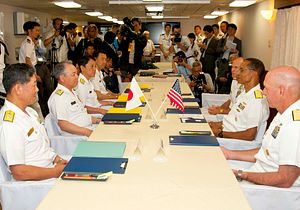China has been rising for over three decades. So why there has not been a genuinely confrontational Sino-U.S. stand-off or a new Cold War between these two top economies? In fact, there have been several symbolic incidents between Washington and Beijing after the honeymoon period that lasted during most of the 1980s. A list of these incidents would include the Yinhe Incident in 1993, the U.S. bombing of the Chinese embassy in Belgrade in 1999, the Hainan Incident in the South China Sea in 2001, and the narrowly-avoided collision in the same waters earlier in 2013. Have these incidents been a series of trial attempts between the U.S. and China to test each other’s respective bottom lines before reaching a total stand-off? The truth is: both countries have stumbled through all the discord, conflicts and collisions, and probably will have to continue to slowly walk together through the years to come. For China, a direct confrontation with the dominant incumbent power through conventional approaches like military alliance-building is unwise and therefore cannot be on Beijing’s agenda.
The doubts and suspicions remain, however. Many view a rising China as a confrontation to the dominant western system, usually by referring to power transition theory’s discussion of “power parity” and the “probability of war.” However, we need to think about this theory’s emphasis on the dominant power’s privileged position to accommodate or engage the rising power. The U.S.’s strategies, tactics, policies, and skills with regard to a rising China, therefore, have long-lasting significances transcending the region of East Asia.
Take the U.S.-Japan alliance, for example. This alliance relationship has been emphasized by both Washington and Tokyo on several occasions, particularly after the eruption of maritime disputes in the East China Sea. The Americans and Japanese may be accounting for facts: the rise of China may not be reversed and China will probably overpass the U.S. economically in less than 20 years. Therefore a strengthened U.S.-Japan alliance will help to ensure the strategic balance in the region in the near future at least. This seems to be a rational choice for a relatively declining U.S. to deal with an increasingly more powerful China.
But if the US truly believes that China will maintain its rise in the foreseeable future, building mutual trust between Washington and Beijing should be at least as important and significant as maintaining a strong U.S.-Japan alliance, if not more important in the long term. Excessively limiting or compressing China’s strategic space will probably be counterproductive; it may cause or at least speed up China’s active counter-measures. In fact, China has been practicing a strategy of “reactive assertiveness” in tackling the Diaoyu/Senkaku Islands dispute, despite the fact that the U.S. and Japan have repeatedly emphasized the important role of the U.S.-Japan alliance and the U.S.’s responsibility to support Japan in a possible conflict over the disputed rocks.
For Japan, maximizing its national interest is completely rational since this is the long-existing principle for all state actors. Will Japan realize its national goals by drawing support from the U.S.-Japan alliance or find a way to break through the alliance limitations in another scenario? Or will Japan cooperate with its Asian neighbors such as China and South Korea to ensure that its national development can be built on sustained regional peace and stability? This is a fundamentally important issue for Japan. In Jean-Pierre Lehmann’s words, Japan must take the first step away from the precipice of war in East Asia.
China, of course, should also acknowledge the importance of reconciliation. In the meantime, though, China has been playing the game with more success. Beijing successfully created an overlapping administration in the disputed area after Japan’s rash move to nationalize the islands in 2012. China also announced an Air Defense Identification Zone in the East China Sea, although most the responses were negative. Given the fact that China’s major neighbors all declared ADIZs decades ago, China took advantage of the opportunity to finally do the same. Beijing is playing the game by ear.
The reaffirming of the U.S.-Japan alliance with regard to the rise of China in East Asia may indicate that the U.S. is trying to avoid the mistake it made in the Middle East. When the U.S. attacked and then reconstructed Iraq, Iran somehow emerged as a strong, ambitious regional power. Of course, Iran is also a potential nuclear state and unfortunately has not been very friendly to Washington so far. Such a serious imbalance has yet to show up in East Asia. The U.S. is relying on the U.S.-Japan alliance to solidify the strategic balance in the region, where China is catching up.
However, the U.S. should be cautious when walking the line between Japan and China. There is no doubt that the U.S.-Japan alliance is a key to ensuring Washington’s strategic interests in the western Pacific. Yet alliances sometimes come with a dilemma: members need the security protection the alliance provides, but fear the limitations that come with alliance relations. How the U.S.-Japan alliance will evolve or even derail will not give China the substantial burden of counter-alliance-building, but China will take all chances to react.
This reminds me of Joseph Nye’s comment in the New York Times in January 2013: If we treat China as an enemy, we guarantee a future enemy. If we treat China as a friend, we keep open the possibility of a more peaceful future. This is also true with regard to Sino-U.S. interactions in the East China Sea dispute.
Given the current political climate in Japan and the U.S.’s regional and global strategies, there may not be much of a possibility that the U.S.-Japan alliance will be a war chariot for Japan. Before there can be significant signs of war preparation between China and Japan, the U.S. should consider a certain degree of regression for the U.S.-Japan alliance. Otherwise, the situation would run completely off the rails, which would affect not only the building of Sino-U.S. mutual trust but also U.S.-Japan relations.

































